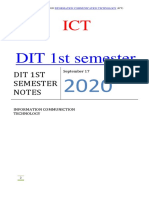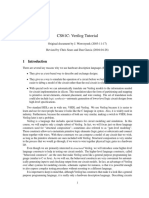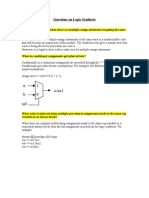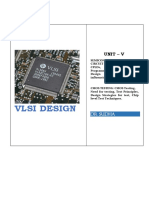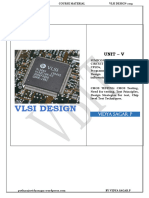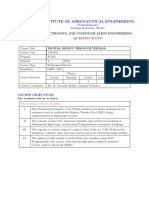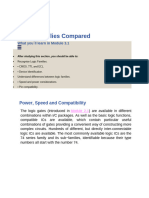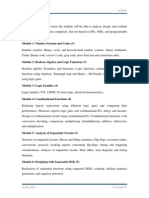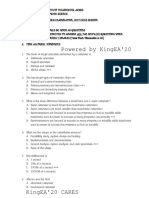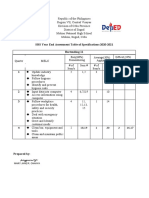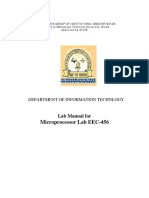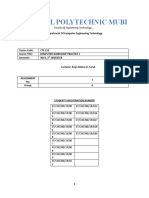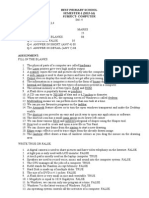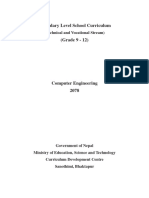Week10 Module10
Week10 Module10
Uploaded by
buscainojed078Copyright:
Available Formats
Week10 Module10
Week10 Module10
Uploaded by
buscainojed078Original Title
Copyright
Available Formats
Share this document
Did you find this document useful?
Is this content inappropriate?
Copyright:
Available Formats
Week10 Module10
Week10 Module10
Uploaded by
buscainojed078Copyright:
Available Formats
PAMANTASAN NG CABUYAO
COLLEGE OF COMPUTING AND ENGINEERING
COURSE CODE: CPP 110
COURSE DESCRIPTION: INTRODUCTION TO HDL
COURSE INTENDED On the completion of the course, student is expected to be able to do the
LEARNING OUTCOMES: following:
1. The ability to code and simulate any digital function in HDL.
2. Understand library modeling, behavioral code and the differences
between them.
3. Understand the differences between simulator algorithms as well
as Logic verification using HDL software tool
4. Learn good coding techniques per current industrial practices
LEARNING MATERIAL FOR 10
WEEK NUMBER:
I. TITLE: Combinational Circuit
II. OBJECTIVES: By the end of this module you should be able to:
1. Understand Boolean Algebra
2. Know how to create minimized logic equation using K-map.
3. Know how to run a Verilog Circuit Simulation.
III. INTRODUCTION:
Combinational logic circuits implement logical functions. Used for
control, arithmetic, and data steering, combinational circuits are the heart
of digital systems. In this module we introduce combinational logic
circuits and describe a procedure to design these circuits given a
specification.
At one time, before the mid-1980s, such manual synthesis of
combinational circuits was a major part of digital design practice. Today,
however, designers write the specification of logic circuits in a hardware
description language (like Verilog) and the synthesis is performed
automatically by a computer-aided design (CAD) program.
IV. CONTENTS:
Lesson Coverage:
- Combinational Circuit
LECTURE NOTES COMPILATION Page 1 of 8
1st Semester A.Y. 2022-2023
PAMANTASAN NG CABUYAO
COLLEGE OF COMPUTING AND ENGINEERING
INTRODUCTION
Combinational logic circuit generates a set of outputs whose state depends only on the current state of the inputs.
Of course, when an input changes state, sometime is required for an output to reflect this change. However, except
for this delay the outputs do not reflect the history of the circuit.
With a combinational circuit, a given input state will always produce the same output state regardless of the
sequence of previous input states. A circuit where the output depends on previous input states is called a sequential
circuit
Combinational logic circuits are important because their static nature makes them easy to design and analyze. As
we shall see, general sequential circuits are quite complex in comparison. In fact, to make sequential circuits
tractable we usually restrict ourselves to synchronous sequential circuits which use combinational logic to
generate a next state function.
Logic circuits that depend only on their inputs are combinational and not combinatorial. While these two words
sound similar, they mean different things. The word combinatorial refers to the mathematics of counting, not to
logic circuits. To keep them straight, remember that combinational logic circuits combine their inputs to generate
an output.
A valuable property of combinational logic circuits is that they are closed under acyclic composition. That is, if
we connect together a number of combinational logic circuits — connecting the outputs of one to the inputs of
another — and avoid creating any loops — that would be cyclic — the result will be a combinational logic circuit.
Thus we can create large combinational logic circuits by connecting together small combinational logic circuits.
Often we start with a truth table that shows the output value for each input combination.
A minterm is a product term that includes each input of a circuit or its complement. The name minterm derives
from the fact that these four input product terms represent a minimal number of input states (rows of the truth
table), just one.
Expressing a logic function as a sum of minterms is a normal form that is unique for each logic function. While
this form is unique, its not particularly efficient. We can do much better by combining minterms into simpler
product terms that each represent multiple lines of our truth table.
Test Bench
To verify that a Verilog module is correct, we write a test bench. A test bench is a piece of Verilog code that is
used during simulation to instantiate the module to be tested, generate input stimulus, and check the module’s
outputs.
While modules must be coded in a strict synthesizable subset of Verilog, test benches, which are not synthesized,
can use the full Verilog language, including looping constructs. In a typical modern digital design project at least
as much effort goes into design verification (writing test benches) as goes into doing the design itself
LECTURE NOTES COMPILATION Page 2 of 8
1st Semester A.Y. 2022-2023
PAMANTASAN NG CABUYAO
COLLEGE OF COMPUTING AND ENGINEERING
Decoder
In general, a decoder converts symbols from one code to another. When used by itself, however, the term decoder
means a binary to one-hot decoder. That converts a symbol from a binary code (each bit pattern represents a
symbol) to a one-hot code (at most one bit can be high at a time and each bit represents a symbol).
Read Only Memory (ROM)
A read-only memory or ROM is a module that implements a look-up table. It accepts an address as input and
outputs the value stored in the table at that address. The ROM is read-only because the values stored in the table
are
predetermined - hard-wired at the time the ROM is manufactured and cannot be changed. A ROM can implement
an arbitrary logic function by storing the truth table of that function in the ROM.
Read – Write Memories (RAM)
A read-write memory or RWM is like a ROM but also allows the contents of the table to be changed or written.
For historical reasons read-write memories are commonly called RAMs. The use of the term RAM to refer to a
RWM
is almost universal, so we will adopt it as well. Strictly speaking, a RAM is a sequential logic device — it has
state and hence its outputs depend on its input history.
The column “multiplexing” for writes is a bit more involved and will not be discussed further here. Most practical
RAMs also use a much more efficient bit cell than the latch plus tri-state buffer shown here. Most static RAMs
(SRAMs) use a six-transistor storage cell while modern dynamic RAMs (DRAMSs) use a cell composed of a
single transistor and a storage capacitor.
Data Sheets
We often will use a building block, or an entire subsystem, in a larger design without understanding its
implementation. When we use a building block in this manner we rely on the specification of the block. This
specification, often called a data sheet gives enough information to use the block, but omits internal details of
how the block is constructed. A data sheet typically contains:
1. A functional description of the block - what the block does. This should be in sufficient detail as to
completely specify the block’s behavior. For a combinational block, a truth table or equation is often used to
specify the block’s function.
2. A detailed description of the inputs and outputs of the block. A signal by signal description that gives the
signal name, width, direction, and a brief description of the signal.
3. A description of all block parameters, if any.
LECTURE NOTES COMPILATION Page 3 of 8
1st Semester A.Y. 2022-2023
PAMANTASAN NG CABUYAO
COLLEGE OF COMPUTING AND ENGINEERING
4. A description of all of the visible state and registers in the block (for sequential blocks).
5. The synchronous timing of the block. The cycle-level timing of the block.
6. The detailed timing. The timing of input and output signals within a single cycle.
7. Electrical properties of the block: power requirements, power consumed, input and output signal levels,
input loads and output drive levels.
Combinational Circuits (CC) are circuits made up of different types of logic gates. A logic gate is a basic building
block of any electronic circuit. The output of the combinational circuit depends on the values at the input at any
given time. The circuits do not make use of any memory or storage device.
A combinational logic circuit as the name itself indicates that it is the combination of various kinds of logic gates.
The combinational circuit goes with the characteristics of:
• At any instant of time, the output is based only on the levels of current input terminals and not on the past
state inputs.
• These circuits do not need any kind of memory states or clock, so the past inputs show no influence on
the current state of the circuit.
• A combinational circuit can intake ‘n’ number of inputs and delivers only one output.
Either the complicated or simple combinational logic, these can be represented through ‘NAND’, ‘NOT’ or ‘NOR
gates’.
Representation of Combinational Logic Circuits
Here, we discuss the three approaches of representing combinational logic circuits
Logic gates – These are the basic building blocks in the development of combinational logic circuits. NAND,
NR, NOT, NOR, OR, AND are all logic gates.
Boolean algebra – This representation stipulates the association that is between Boolean variables and is used to
design digital circuitry through logic gates. Every digital system is basically designed with logic gates and so
Boolean algebra is the one foremost approach to represent a combinational logic circuit.
Truth table – This method computes the operational values of logical expressions for every combination of
values taken by their logical variables. For every single-bit output in the logic block, a truth table is necessary to
represent the logic. In general, all the output columns are represented in a single table.
For example, an expression that can be represented in the above three approaches as follows:
LECTURE NOTES COMPILATION Page 4 of 8
1st Semester A.Y. 2022-2023
PAMANTASAN NG CABUYAO
COLLEGE OF COMPUTING AND ENGINEERING
Classification of Combinational Logic Circuits
Combinational logic circuits are classified as below
The foremost implementation of the combinational logic circuit is Multiplexer and de-multiplexer. In these, many
numbers of inputs or outputs are on a single line and the logic gates are employed to decode corresponding output
for the specified input.
LECTURE NOTES COMPILATION Page 5 of 8
1st Semester A.Y. 2022-2023
PAMANTASAN NG CABUYAO
COLLEGE OF COMPUTING AND ENGINEERING
Applications of Combinational Logic Circuit
Combinational logic circuits are the basic building blocks of digital systems. They have an extensive variety of
applications. They are used in
• Digital measuring techniques
• Digital processing
• Industrial processing
• Computers
• Calculators
• Digital Communication
Combinational logic circuits as arithmetic and logic circuits have applications as
• Comparators
• Programmable logic devices
• Adders & Subtractors
Combinational logic circuits as data transmission circuits have applications as
• Parallel to serial convertors
• Data routing
• Serial to parallel converters
• Bit Compression
• ADC and DAC
• Encoders & Decoders
Combinational logic circuits as code converter circuits have applications as
• Binary to gray code conversion
• Gray to Binary conversion
• BCD to Excess-3
• Excess-3 to BCD
• Seven segment code
Combinational Logic Circuit Design Procedure
The below steps clearly explain the design procedure of how a combinational logic system is developed
1. Identifying the required number of input and output variables
2. Symbolizing all the identified input and output variables
3. Express the relationship between these variables
4. With the relationship, construct the truth table
5. Derive the Boolean expression for all the outputs
6. Minimize the Boolean expression to reduce the complication
7. Design the logic diagram with the help of Boolean expressions
LECTURE NOTES COMPILATION Page 6 of 8
1st Semester A.Y. 2022-2023
PAMANTASAN NG CABUYAO
COLLEGE OF COMPUTING AND ENGINEERING
To minimize Boolean expressions, various approaches are followed. K-map and Quinne-McCluskey are the most
followed techniques. The above-stated procedure is a streamlined and effective technique. Through this, the
design of circuits seems to be completely reliable.
LECTURE NOTES COMPILATION Page 7 of 8
1st Semester A.Y. 2022-2023
PAMANTASAN NG CABUYAO
COLLEGE OF COMPUTING AND ENGINEERING
V. REFERENCES: Roth, C.H. Jr. And John, L. K. (2018). Digital Systems Design Using VHDL (3rd
ed.). Texas, USA: Cengage Unlimited
Brown, S. and Vranesic, Z. (2009). Fundamentals of Digital Logic with VHDL
Design. (3rd ed.). New York, NY: McGraw-Hill
Online Readings and Guide
Hardware Description Language | VLSI Tutorial | Mepits
VHDL || Electronics Tutorial (electronics-tutorial.net)
Index of /ece232/pdf (umass.edu)
VI. ASSESSMENT TASK:
See Attached file given by the instructor
LECTURE NOTES COMPILATION Page 8 of 8
1st Semester A.Y. 2022-2023
You might also like
- Information and Communication Technology NOTES DIT PeshawarDocument66 pagesInformation and Communication Technology NOTES DIT PeshawarSafeer AhmadNo ratings yet
- Design and Implementation of Traffic Controller Using VHDL: Interim Project ReportDocument21 pagesDesign and Implementation of Traffic Controller Using VHDL: Interim Project ReportAugusto Germano da SilvaNo ratings yet
- Vlsi ManualDocument110 pagesVlsi ManualSam Joel.DNo ratings yet
- Unit IV Verilog NotesDocument69 pagesUnit IV Verilog NotesR R DeshmukhNo ratings yet
- VLSI Answer KeyDocument15 pagesVLSI Answer Keyrendezvous2k23No ratings yet
- Verilog - Excellent ExplanationDocument18 pagesVerilog - Excellent ExplanationRida AmjadNo ratings yet
- Vlsi Unit-VDocument41 pagesVlsi Unit-VJay SubbareddyNo ratings yet
- Microcontrollers 2017-18 Lab ManualDocument58 pagesMicrocontrollers 2017-18 Lab ManualSUNIL KUMAR100% (1)
- Ver I Log TutorialDocument18 pagesVer I Log Tutorialritam yadavNo ratings yet
- Questions On Logic SynthesisDocument11 pagesQuestions On Logic SynthesisrAM89% (9)
- 19ECE349-RISC Processor Design Using HDLDocument325 pages19ECE349-RISC Processor Design Using HDLJatin JNo ratings yet
- Synthesis AlDocument7 pagesSynthesis AlAgnathavasiNo ratings yet
- 19ECE349-RISC Processor Design Using HDLDocument195 pages19ECE349-RISC Processor Design Using HDLVaishnavi PanduranganNo ratings yet
- Department of Ece Subject Code: Ec1203 Digital Electronics (For Third Semester Ece) Two Mark Questions-AnswersDocument12 pagesDepartment of Ece Subject Code: Ec1203 Digital Electronics (For Third Semester Ece) Two Mark Questions-AnswersSurendar PNo ratings yet
- CS61c: Verilog Tutorial: J. Wawrzynek October 17, 2007Document20 pagesCS61c: Verilog Tutorial: J. Wawrzynek October 17, 2007Hassan AliNo ratings yet
- Vlsi Design Unit 5Document37 pagesVlsi Design Unit 5Chennam VaishnaviNo ratings yet
- Hardware Description LanguageDocument29 pagesHardware Description LanguagemuktikantaNo ratings yet
- Fpga Interview QuestionsDocument9 pagesFpga Interview QuestionsV SharmaNo ratings yet
- UVM Tech NotesDocument68 pagesUVM Tech Notesrf.rakeshNo ratings yet
- Vlsi Design Unit 5 2019Document37 pagesVlsi Design Unit 5 2019Jpradha KamalNo ratings yet
- Digital SystemsDocument390 pagesDigital SystemsKetan PandeyNo ratings yet
- Traffic Control Using VHDLDocument18 pagesTraffic Control Using VHDLnikky234No ratings yet
- Prelim Module5 - BDocument7 pagesPrelim Module5 - BCelimen, John Renz C.No ratings yet
- Simplified FPGA Design Implementation FlowDocument36 pagesSimplified FPGA Design Implementation FlowRajendra PrasadNo ratings yet
- Vlsi NotesDocument5 pagesVlsi NotesDiwakar TiwaryNo ratings yet
- Logical Analysis For Switching Sequence Generation in 15-Level Reduced Switch MLIDocument9 pagesLogical Analysis For Switching Sequence Generation in 15-Level Reduced Switch MLIK SDNo ratings yet
- SYNTHESISDocument8 pagesSYNTHESISmayur100% (2)
- Cad 2 MarksDocument13 pagesCad 2 MarksAnonymous JnvCyu85No ratings yet
- VLSI DesignDocument19 pagesVLSI DesignEr Deepak GargNo ratings yet
- Vlsi, VHDL and PCB Design: in Electronics and Communication Engineering byDocument45 pagesVlsi, VHDL and PCB Design: in Electronics and Communication Engineering byAbhishek DeyNo ratings yet
- Electronic Circuit Simulation - Wikipedia, The Free EncyclopediaDocument4 pagesElectronic Circuit Simulation - Wikipedia, The Free EncyclopediaetherhuntNo ratings yet
- Signals 03 00020Document13 pagesSignals 03 00020FRANCO BOZZETTONo ratings yet
- Session - 8 - PLA PALDocument14 pagesSession - 8 - PLA PALmohammedsaniyaamrinNo ratings yet
- Nirma University Institute of Technology: B. Tech. in Electronics and Communication Engineering Semester - VDocument15 pagesNirma University Institute of Technology: B. Tech. in Electronics and Communication Engineering Semester - VPragya jhala100% (1)
- SoC Design - A ReviewDocument131 pagesSoC Design - A ReviewSambhav VermanNo ratings yet
- LcssDocument24 pagesLcsswefwfwNo ratings yet
- Institute of Aeronautical Engineering (Autonomous) : Electronics and Communication EngineeringDocument40 pagesInstitute of Aeronautical Engineering (Autonomous) : Electronics and Communication EngineeringMano HarNo ratings yet
- Ability Enhancement Lab Manual Atria ITDocument45 pagesAbility Enhancement Lab Manual Atria ITGayatri JoshiNo ratings yet
- LOGIC FAMILIESDocument7 pagesLOGIC FAMILIESdhana lalithaNo ratings yet
- Vlsi Lab Manual 2013Document64 pagesVlsi Lab Manual 2013harish33330% (1)
- LOW-LEVEL Design EntryDocument24 pagesLOW-LEVEL Design Entryrpa projectNo ratings yet
- Tutorial (Solution)Document15 pagesTutorial (Solution)Maga LakshmiNo ratings yet
- Digital ElectronicsDocument228 pagesDigital ElectronicsMujeeb AbdullahNo ratings yet
- VLSI DesignDocument55 pagesVLSI DesignClique for Applied Research in Electronic TechnologyNo ratings yet
- CBS1 DSDDocument2 pagesCBS1 DSDthahseenthahir08No ratings yet
- VHDL: A Language For Specifying LogicDocument24 pagesVHDL: A Language For Specifying Logicansh_sdpNo ratings yet
- CDN Creating Analog Behavioral ModelsDocument24 pagesCDN Creating Analog Behavioral ModelsRafael MarinhoNo ratings yet
- Design of RISC Processor Using VHDL and CadenceDocument2 pagesDesign of RISC Processor Using VHDL and CadencepoojaNo ratings yet
- Introduction To Vlsi: 1.1 VerilogDocument3 pagesIntroduction To Vlsi: 1.1 VeriloghfytdyjNo ratings yet
- Vlsi Design - Ec - 701 - Unit - IDocument37 pagesVlsi Design - Ec - 701 - Unit - Iangelcrystl4774No ratings yet
- Verilog AssignDocument8 pagesVerilog Assignafodcwdycgpena100% (1)
- Summer Training VHDLDocument38 pagesSummer Training VHDLmjcetpaNo ratings yet
- PracticeDocument1 pagePracticeshiva03505No ratings yet
- FPGA Interview QuestionsDocument11 pagesFPGA Interview Questionssneha587No ratings yet
- PLC Programming Using RSLogix 500 & Industrial Applications: Learn ladder logic step by step with real-world applicationsFrom EverandPLC Programming Using RSLogix 500 & Industrial Applications: Learn ladder logic step by step with real-world applicationsRating: 5 out of 5 stars5/5 (1)
- Lenovo Moto Smart Assistant User Guide v4.2.0Document51 pagesLenovo Moto Smart Assistant User Guide v4.2.0Javier0% (1)
- CSC 102 Exam - 1-1Document75 pagesCSC 102 Exam - 1-1kayode oluwarotimiNo ratings yet
- MC68HC908JL3EDocument184 pagesMC68HC908JL3EFabio RodriguesNo ratings yet
- C2 Class 3Document17 pagesC2 Class 3ah3137260No ratings yet
- Xerox: Docucolor 240/250 Engine Software Set Install InstructionsDocument11 pagesXerox: Docucolor 240/250 Engine Software Set Install InstructionsJorge montañezNo ratings yet
- Computer SystemDocument63 pagesComputer SystemEden Mae Sagadraca TabliagoNo ratings yet
- SHS Year End Assessment Table of Specifications 2020-2021 Bartending 11Document4 pagesSHS Year End Assessment Table of Specifications 2020-2021 Bartending 11Mary Jane Repaja CanayaNo ratings yet
- PLC Teaching BookDocument167 pagesPLC Teaching BookMitchell Daniels100% (5)
- Introduction To Asic DesignDocument53 pagesIntroduction To Asic DesignPerumal NamasivayamNo ratings yet
- Jawaban Unit 4 BasingDocument3 pagesJawaban Unit 4 BasingCendra WasihNo ratings yet
- COA Module 4 FinalDocument22 pagesCOA Module 4 FinalAkhil KrishnaNo ratings yet
- Speedtronic™ Mark V: GE Industrial SystemsDocument14 pagesSpeedtronic™ Mark V: GE Industrial SystemsJulio De la RosaNo ratings yet
- Dronacharya Microprocessor - Lab - 17012013Document25 pagesDronacharya Microprocessor - Lab - 17012013virendra.aryaNo ratings yet
- How To Enable Debugging For FLEXSPI NOR Flash: 2.1 EVK SettingsDocument21 pagesHow To Enable Debugging For FLEXSPI NOR Flash: 2.1 EVK SettingsMattS1234No ratings yet
- Cte 212 Group A Original-FinalDocument15 pagesCte 212 Group A Original-FinalJosephishakuNo ratings yet
- Computer Architechture - BcaDocument4 pagesComputer Architechture - Bcafasnabasheer911No ratings yet
- DatasheetDocument13 pagesDatasheetAshok GudivadaNo ratings yet
- Diia Specification: Dali Part 250 - Integrated Bus Power SupplyDocument10 pagesDiia Specification: Dali Part 250 - Integrated Bus Power Supplytufta tuftaNo ratings yet
- Microsoft Office 2010A Modern Approach - EInternationalDocument590 pagesMicrosoft Office 2010A Modern Approach - EInternationalAnonymous D430wlgNo ratings yet
- Microprocessor Theory and Applications With 6800068020 and Pentium TQW - DarksidergDocument590 pagesMicroprocessor Theory and Applications With 6800068020 and Pentium TQW - DarksidergSuraj Kumar Gupta100% (4)
- Itgs Notes CHDocument1 pageItgs Notes CHCher LongNo ratings yet
- UntitledDocument5 pagesUntitledapi-233604231No ratings yet
- BiosDocument27 pagesBiosDrift GeeNo ratings yet
- FM24C04D Ds EngDocument28 pagesFM24C04D Ds EngJuan Daniel Angeles AnguloNo ratings yet
- Cambridge Igcse Information and Communication Technology Thirdnbsped 9781398318540 139831854xDocument89 pagesCambridge Igcse Information and Communication Technology Thirdnbsped 9781398318540 139831854xbadhri36% (11)
- 1.4 (PPT) Computer Basics (Hardware and Storage)Document19 pages1.4 (PPT) Computer Basics (Hardware and Storage)KeepinNo ratings yet
- Knowing The Basics of PlcsDocument9 pagesKnowing The Basics of PlcsМилорад ПрњићNo ratings yet
- Ami Aptio Afu User Guide NdaDocument15 pagesAmi Aptio Afu User Guide NdahemarnoNo ratings yet
- Secondary Level School Curriculum: (Technical and Vocational Stream)Document321 pagesSecondary Level School Curriculum: (Technical and Vocational Stream)kumarishu1423No ratings yet

